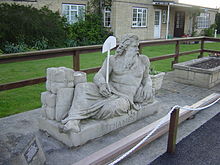St John's Lock
Coordinates: 51 ° 41 ′ 23.7 " N , 1 ° 40 ′ 46.3" W.

St John's Lock is the first lock on the Thames in England. It is near the village of Lechlade , Gloucestershire . The name of the lock comes from an abbey that was founded in 1250 but no longer exists. The lock was built of stone in 1790 by the Thames Navigation Commission .
The next weir downstream is below St John's Bridge , where the River Cole and River Leach flow into the Thames.
There is a sculpture by Father Thames on the lock keeper's house. The sculpture was created in 1854 for the Cyrstal Palace. It was later relocated to the source of the Thames and finally set up at the lock.
history
A lock at this point was made necessary by the opening of the Trent and Severn Canal in November 1789. The lock was built by J. Nock in 1790. In the early days there were complaints that intrusive boatmen were not paying the fees. The first lock keeper's house was built in 1830 because the lock keeper was not allowed to be an innkeeper according to the rules and had to give up his apartment in the Trout Inn. The poor condition of the lock was reported in 1857 and repairs were carried out in 1867. In 1907 the lock was rebuilt and a new lock keeper's house was built on the other side of the lock.
Access to the lock
The lock can be easily reached from St John's Bridge about 1.5 km outside Lechlade on the A417.
The section of the river above the lock
The river meanders for around 1.2 km to Lechlade, where it passes the Halfpenny Bridge, which is so called because its passage used to cost tolls. About 800 m beyond Lechlade there is a connection to the former Thames and Severn Canal, which connected the Thames to the River Severn via the Stroudwater Navigation and the Gloucester and Sharpness Canal . The Thames and Severn Canal will be restored and so it is possible that shipping beyond Lechlade can be resumed. The River Coln also joins the Thames at the canal link, so it is possible to turn a 70 foot long canal boat with caution. There are no other locks above Lechlade, which is usually considered the end of the navigable Thames. Shipping is possible as far as Cricklade and small boats can travel another 4.8 km to Lechlade, if the water level allows it.
The Thames Path runs on the south bank past Lechlade to Inglesham and crosses the river next time at the Water Eaton Bridge.
See also
Web links
Individual evidence
- ^ Sharp, David (2001) The Thames Path , National trail guides 16, London: Aurum, ISBN 1-85410-773-9 , p. 46
- ↑ Fred. S. Thacker The Thames Highway: Volume II Locks and Weirs, 1920 - republished 1968, David & Charles, Newton Abbot
- ↑ Nicholson Waterways Guide, Volume 7 (2006) ISBN 0-00-721115-5
